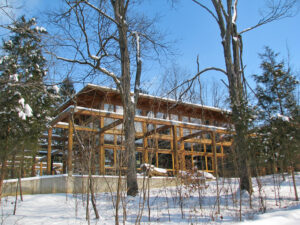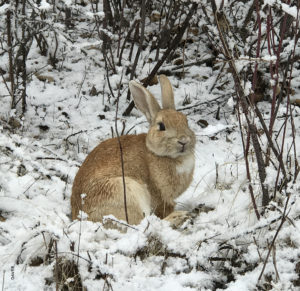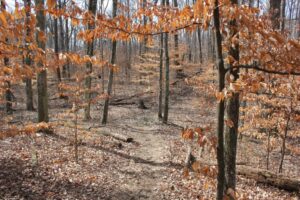By volunteer
 Bernheim may see the most visitors in the fall. No doubt the colors are magnificent, but if you haven’t taken the time to enjoy Bernheim in the winter you are missing out. In fact, honorary Bernheim Trustee, Marshall Eldred will tell you that winter is his favorite time of the year at Bernheim. We asked him to share his perspective on what makes winter at Bernheim so wonderful.
Bernheim may see the most visitors in the fall. No doubt the colors are magnificent, but if you haven’t taken the time to enjoy Bernheim in the winter you are missing out. In fact, honorary Bernheim Trustee, Marshall Eldred will tell you that winter is his favorite time of the year at Bernheim. We asked him to share his perspective on what makes winter at Bernheim so wonderful.
By Marshall Eldred
The house where I grew up in Louisville backed up to a very large wooded area with a good-sized creek. As kids we hiked and explored those woods to our hearts’ content. That outdoor play, coupled with Scouting, is how I first developed my appreciation of nature. My family and I continue to make a conscious effort to maintain that connection no matter the season, and Bernheim is where we often go.
In particular, it is winter when I feel even more connected to nature at Bernheim. It’s a little hard to explain, but I simply feel more alive. All of my senses are sharpened outside in the winter. Maybe it’s because of the cold air against my face. Maybe it’s the bright blue skies or the fact that you can see so much more of the land and feel more a part of it. Gone are the bugs and snakes and the heat and humidity of summer. It is just you and the forest. It’s spectacular!
 With the absence of foliage from the trees, sound travels better in the winter, so you often hear animals stirring long before you can see them – deer, turkeys, hawks and even eagles. Whether it’s the crunching of leaves under my feet or the gurgling or trickling of water under a frozen creek the sounds are as crisp and clean as the frost that often blankets the ground.
With the absence of foliage from the trees, sound travels better in the winter, so you often hear animals stirring long before you can see them – deer, turkeys, hawks and even eagles. Whether it’s the crunching of leaves under my feet or the gurgling or trickling of water under a frozen creek the sounds are as crisp and clean as the frost that often blankets the ground.
Speaking of wildlife, on one memorable winter hike with friends, we came across a frozen pond and found literally thousands of frog eggs just waiting for spring to hatch. It was fascinating to see life at its very fragile beginning. Similarly, you can see the buds on the trees just waiting for the first warm days of spring.
We frequently hike the Millennium Trail and both the ridges and valleys in the winter offer amazing surprises. The seven knobs along the trail allow you to see the distinct contour of the land. Unlike the rest of the year, you can see the far ridges through the trees, the valleys, the creeks…
And the colors, yes the colors, of winter are remarkable. In the spring, summer and fall, the color is certainly beautiful, but perhaps a bit overwhelming. In the winter things that otherwise don’t stand out now do, like clumps of evergreens across the valley or bright green moss on the ground. The contrast is startling.
 I didn’t know how many shades of brown and red there were until I hiked the trails of Bernheim in the winter. There are the tan leaves of the Beech trees, leaves that don’t fall off until spring. The Sycamore trees have great big patches of white bark. They grow along the creeks, so imagine standing atop a ridge and looking down at the Sycamores in the valley below. It looks like white paint, outlining the route of the creek.
I didn’t know how many shades of brown and red there were until I hiked the trails of Bernheim in the winter. There are the tan leaves of the Beech trees, leaves that don’t fall off until spring. The Sycamore trees have great big patches of white bark. They grow along the creeks, so imagine standing atop a ridge and looking down at the Sycamores in the valley below. It looks like white paint, outlining the route of the creek.
I always try to identify trees without their leaves, looking at their unique shape, patterns and the architecture of their bark, trunks, and branches. Doing so has deepened connection, understanding and appreciation of nature.
By far, the one of the most beautiful things about winter at Bernheim is walking in the snow, or even better, being out on a trail as it begins to snow. It’s both eerily quiet and incredibly peaceful. When it snows, we make a point of going to Bernheim.
So if you haven’t taken the time to explore Bernheim in the winter, I encourage you to do so. For me there is no better time. I invite you to experience that same oneness with the land that, I believe, only winter can offer.
This article originally appeared in the Winter, 2014 issue of Bernheim’s quarterly newsletter, the forest echo.

